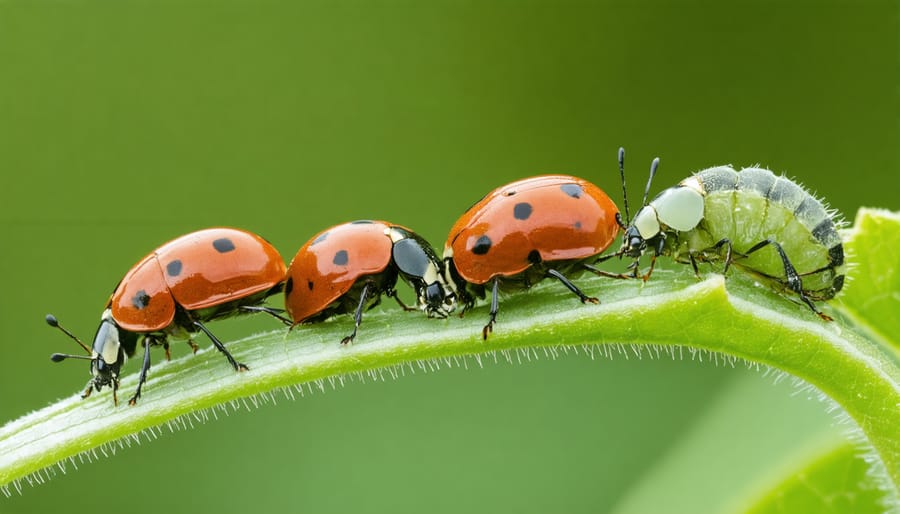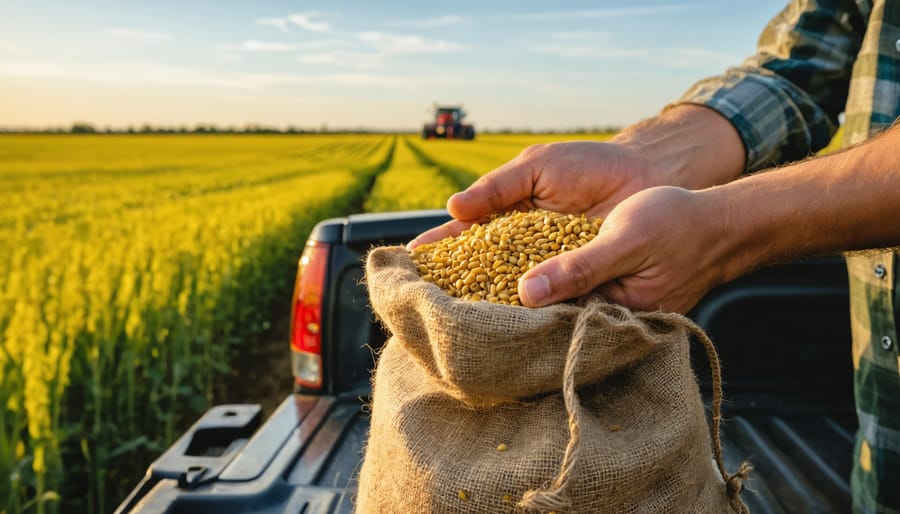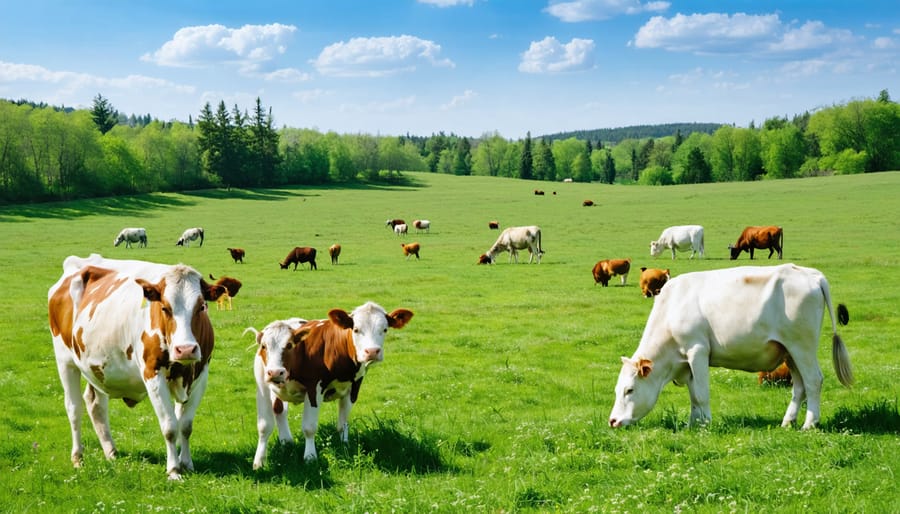Integrate beneficial insects like ladybugs and predatory wasps into your organic farming system to create natural pest control cycles that maintain certification standards. Strategic companion planting with aromatic herbs such as dill, fennel, and yarrow attracts these beneficial insects while deterring harmful pests from your main crops. Establish diverse hedgerows and buffer zones around field perimeters to provide habitat for pest-controlling birds and beneficial insects, creating a resilient ecosystem that supports long-term pest management.
Canadian organic farmers have reduced pest damage by up to 60% through these biological control methods, while maintaining compliance with Canadian Organic Standards. Physical barriers, including row covers and insect netting, provide immediate protection during critical growth stages without compromising organic certification. Regular soil testing and maintenance of optimal pH levels strengthen plant resistance naturally, reducing susceptibility to common agricultural pests across Alberta’s diverse growing regions.
Crop rotation stands as the cornerstone of organic pest management, breaking pest life cycles and maintaining soil health. By implementing these proven strategies, farmers across Canada are successfully managing pest populations while building stronger, more sustainable agricultural operations that meet both certification requirements and production goals.
Building Your Organic Pest Defense Arsenal
Biological Control Champions
In organic farming, nature’s own pest control specialists play a crucial role in maintaining healthy crop systems. Ladybugs, often called the farmer’s best friend, are voracious aphid hunters, with a single beetle capable of consuming up to 5,000 aphids in its lifetime. Here in Alberta, many farmers release ladybugs early in the growing season to establish natural pest control.
Ground beetles are another powerful ally, patrolling the soil surface at night to feed on slugs, cutworms, and other destructive pests. These beneficial insects are particularly effective in root vegetable crops and can be attracted by maintaining permanent mulch strips between rows.
Parasitic wasps, despite their intimidating name, are harmless to humans but deadly to many crop-destroying caterpillars and beetles. Alberta organic farmer Sarah Mitchell reports: “Since introducing parasitic wasps to our cabbage fields, we’ve seen a 70% reduction in pest damage without using any sprays.”
Beneficial nematodes and soil microorganisms work underground, controlling root-feeding pests while improving soil health. These microscopic warriors are particularly effective against wireworms and root maggots, common challenges in Prairie vegetable production.
To attract and maintain these biological control champions, consider planting flowering borders with native species like yarrow and goldenrod, which provide nectar and shelter for beneficial insects throughout the growing season.

Plant-Based Solutions
Nature provides powerful solutions for pest management through botanical alternatives and strategic planting. Many Canadian organic farmers have found success using approved pesticides for organic farming derived from plants, such as neem oil, pyrethrum from chrysanthemums, and garlic-based sprays.
Companion planting has proven particularly effective in Alberta’s climate. By strategically placing aromatic herbs like dill and cilantro throughout your crops, you can naturally deter harmful insects while attracting beneficial ones. Marigolds, known locally as “garden guardians,” help protect vegetables from nematodes and other soil-borne pests when planted as borders.
Many Prairie farmers have reported success with intercropping, where multiple plant species grow together, creating natural pest barriers. For instance, planting onions or leeks alongside carrots helps ward off carrot flies, while nasturtiums act as trap crops for aphids, protecting your main harvest.
Indigenous plants like yarrow and elderberry can be cultivated as natural pest deterrents, offering dual benefits as habitat for beneficial insects. Local farming cooperatives have documented success using these native species, particularly in market gardens and small-scale operations.
Remember to rotate these plant-based solutions seasonally and maintain proper spacing to maximize their effectiveness while preventing disease pressure.

Prevention: Your First Line of Defense
Crop Rotation Success Stories
The Henderson family farm in Lacombe County stands as a shining example of successful crop rotation implementation. Over the past five years, their 640-acre operation has reduced pest incidents by 75% through strategic rotation of cereals, legumes, and brassicas. “By introducing mustard as our break crop, we’ve seen a significant decline in flea beetle populations that used to plague our canola,” explains Sarah Henderson, who transitioned to organic farming in 2015.
In the Peace River region, Marcus Zhang’s innovative four-year rotation system has become a model for other organic farmers. His approach includes alternating between wheat, peas, oats, and clover, which has virtually eliminated wireworm issues while improving soil health. “The key is patience and planning,” Zhang notes. “We’ve cut our pest management costs in half since implementing this system.”
The Wheatland Farming Collective, comprising five family farms near Strathmore, demonstrates the power of community-based rotation planning. Their coordinated rotation schedule across 2,000 combined acres has created natural barriers against pest migration. Since 2018, they’ve documented a 60% reduction in grasshopper damage without using any chemical interventions.
Perhaps most notably, the Miller farm near Red Deer has transformed their pest management through an extended six-year rotation cycle. By incorporating flowering crops like alfalfa and buckwheat, they’ve attracted beneficial insects that naturally control harmful pests. Their approach has not only eliminated the need for organic pesticides but has also increased their overall yield by 20% compared to their pre-rotation numbers.
Building Resilient Soil Systems
Building healthy, resilient soil is your first line of defense against pest problems in organic farming. Here in Alberta, we’ve seen remarkable success stories from farmers who focus on soil health as their primary pest management strategy.
A well-structured soil system naturally deters many common agricultural pests through multiple mechanisms. When you maintain proper soil organic matter levels (ideally 3-5%), you create an environment that supports beneficial microorganisms and natural pest predators. These organisms help keep pest populations in check while improving overall soil structure.
Crop rotation plays a crucial role in building pest-resistant soil systems. By changing crops annually, you disrupt pest life cycles and prevent the buildup of species-specific problems. Many Alberta farmers have found success with three to four-year rotation plans that include deep-rooted crops like alfalfa to improve soil structure.
Incorporating cover crops between main growing seasons helps maintain soil biodiversity and provides habitat for beneficial insects. Common cover crop choices in our region include fall rye, which can survive our harsh winters, and clover varieties that add nitrogen to the soil.
Proper pH management (typically maintaining levels between 6.0-7.0) and balanced mineral content create conditions where plants naturally resist pest pressure. Regular soil testing, ideally every two to three years, helps you track these important parameters and make informed adjustments.
Remember to maintain adequate soil moisture levels through proper irrigation and organic matter management. Well-hydrated plants are naturally more resistant to pest damage, while stressed plants often become easy targets for opportunistic pests.
Documentation and Compliance
Essential Records for Certification
Maintaining detailed records is crucial for organic certification compliance when implementing pest control methods. Every pest management action must be documented in your farm’s Organic System Plan (OSP). Keep a comprehensive log that includes dates, locations, target pests, control methods used, and outcomes of each intervention.
Essential records include inventory lists of all substances used for pest control, complete with product labels and verification of compliance with organic standards. Document your monitoring activities, including pest population surveys, damage assessments, and weather conditions that may influence pest pressure.
For Alberta farmers, the Canadian Organic Regime requires maintenance of records for at least five years. Include photographs of pest damage and control measures, receipts for purchased inputs, and maps showing buffer zones and trap locations. Track your crop rotation plans and beneficial insect habitats, as these are integral to your preventive pest management strategy.
Create a decision-making framework that outlines your response protocols for different pest scenarios. This should include thresholds for action and justify why specific control methods were chosen over others. Keep records of any consultations with pest management advisors or certification bodies.
Remember to document both successful and unsuccessful control measures – this information is valuable for improving your pest management strategy and demonstrating your commitment to organic principles during inspections.

Audit-Ready Practices
Maintaining detailed records is crucial for demonstrating compliance with Canadian organic certification standards during inspections. Create a comprehensive pest management logbook that documents all control methods used, including dates, locations, and outcomes. Record keeping should include monitoring data, trap counts, and any biological control releases.
Keep receipts and documentation for all approved pest control products and beneficial insects purchased. Maintain field maps showing buffer zones and ecological areas that support natural pest control. Document your crop rotation plans and cover crop strategies, as these are essential components of organic pest management.
Prepare photo evidence of your integrated pest management practices, such as beneficial insect habitats and mechanical control methods. Regular soil testing results should be available to show how your fertility management supports plant health and natural pest resistance.
During inspections, be ready to explain your decision-making process for pest control interventions. Have your pest monitoring protocols written down and maintain records of staff training in organic pest management methods. Consider creating a quick-reference guide that outlines your farm’s approved pest control procedures and emergency response plans for severe pest outbreaks.
Remember to update your organic system plan annually, ensuring all pest control practices align with current regulations. This proactive approach not only satisfies certification requirements but also helps optimize your pest management strategy.
Real Results from Alberta’s Fields
Local farmers across Alberta are demonstrating remarkable success with organic pest control methods, proving that sustainable farming practices in Alberta can effectively manage pest issues while maintaining organic certification.
Sarah Johnston, who operates a 400-hectare organic grain farm near Red Deer, successfully eliminated a severe flea beetle infestation in her canola crop using trap crops and beneficial insects. “We planted mustard as a trap crop around our main fields,” Johnston explains. “This attracted the beetles away from our canola, while we released lacewings that naturally prey on these pests.”
Near Lethbridge, the Martinez family farm has been implementing companion planting strategies for five years. Their innovative approach includes intercropping dill and carrots to repel carrot rust flies, resulting in a 40% reduction in crop damage without chemical interventions.
The Wheatland Organic Cooperative, representing 15 farms in central Alberta, reports successful implementation of crop rotation strategies that have reduced wireworm populations by 65% over three years. Their systematic approach involves rotating cereals with legumes and incorporating brown mustard as a biofumigant.
Third-generation farmer Mike Thompson from Peace River shares his experience with beneficial habitat creation: “We’ve established permanent hedgerows with native flowering species around our fields. These serve as homes for predatory insects that help control aphids and other pests. Our pesticide-free management has actually improved our soil health and crop resilience.”
These success stories demonstrate that organic pest control methods not only work but can be economically viable when properly implemented. The key has been patience, careful observation, and commitment to long-term ecological balance rather than quick fixes.
Embracing organic pest control methods isn’t just about meeting certification requirements – it’s about building a sustainable future for Canadian agriculture. Throughout this guide, we’ve explored how traditional wisdom and modern innovation come together to create effective, environmentally conscious pest management solutions.
Remember that successful organic pest control is built on three fundamental pillars: prevention through biodiversity and soil health, monitoring and early detection, and integrated management using approved methods. By implementing these strategies gradually, you can develop a robust pest management system that works for your specific farm conditions.
Start small by choosing one or two methods that align with your current operations. Perhaps begin with companion planting or introducing beneficial insects. As you gain confidence and experience, expand your approach to include more sophisticated techniques.
Connect with local organic farming associations and fellow producers who can share their experiences and insights. The organic farming community in Alberta and across Canada is known for its collaborative spirit and willingness to support new adopters.
Take advantage of available resources through provincial agricultural extension services and certification bodies. They can provide valuable guidance as you transition to or enhance your organic pest control practices.
Remember, organic pest management is a journey of continuous learning and adaptation. Your efforts contribute not only to your farm’s success but also to Canada’s leadership in sustainable agriculture.










